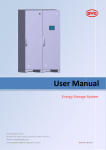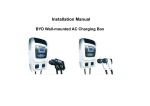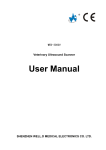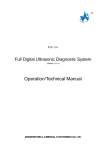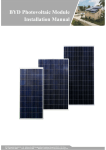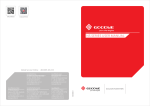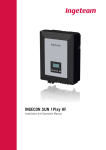Download User Manual - Energy365 - Now you can use solar power after the
Transcript
User Manual Distributed Energy Storage System DESS-B08P03A-A BYD COMPANY LIMITED NO.3009, BYD Road, Pingshan, Shenzhen, 518118, P.R.China Website: www.bydenergy.com Providing green, stable and safe electric power. Build Your Dreams Distributed Energy Storage System Build Your Dreams Content 1 Brief Introduction .................................................................................................. 1 2 Installation............................................................................................................. 1 2.1 Component List .................................................................................................................... 1 2.2 Recommended Cable Sizes ................................................................................................... 2 2.3 Installation Placement .......................................................................................................... 3 2.4 Electrical Connection ............................................................................................................ 4 3 Startup and Shutdown .......................................................................................... 5 3.1 System Startup...................................................................................................................... 7 3.2 System Shutdown ................................................................................................................. 8 3.3 Selecting the Bypass Function .............................................................................................. 8 4 Language and Date Settings .................................................................................. 8 5 Working Modes ................................................................................................... 12 5.1 Detailed Setup for Matching Load Working Mode ............................................................. 12 5.2 Detailed Setup for Maximum Storing Energy Mode .......................................................... 14 5.3 Detailed Setup for Load Shifting Mode .............................................................................. 16 5.4 Detailed Setup for Tariff Management ............................................................................... 18 6 Maintenance ....................................................................................................... 21 DESS Connection Topology ........................................................................................ 23 DESS Specifications.................................................................................................... 24 Distributed Energy Storage System 1 Build Your Dreams Brief Introduction The distributed energy storage system (DESS) is designed and developed by BYD Auto Industry Company Limited, and can be widely used in residential and commercial applications. DESS is a power supply device with multiple working modes. It can operate in different working modes to suit a range of requirements. In this way, the system provides the user with a flexible energy storage system. This manual outlines the specifications, operation and installation of DESS-B08P03A-A. 2 Installation Before installation, please check whether the cabinet and components inside the cabinet are completed and have not been damaged in transit. If you have any questions, please contact your local agent or the supplier BYD Auto Industry Company Limited. NOTE: During the installation and operation process, it is forbidden for installer/customer to change the default settings and internal wiring of the DESS, the doing so will void the warranty. If there are any special requirements needed, please contact your local dealer for support. 2.1 Component List After unpacking the system, please refer to the following table to check whether the components are complete, and free from damage. Table 2.1 System Component List System Component 1 System Cabinet (incl. 4 battery modules, 1BMS, 1 Touch Screen, 1 inverter, etc.) 1 PCS 2 User Manual 1PCS 3 FAT Report 1 PCS Document 1 Distributed Energy Storage System Build Your Dreams Fig 2.1 System cabinet 2.2 Recommended Cable Sizes The electrical connection of the single phase AC-bus DESS-B08P03A-A should be completed using the following cable size as a guide shown in Table2.2. The length of cables shall be determined based on the actual installation location and load requirements. Warning: Please use the cable sizes recommended by BYD. As a guide only. (DC, AC cables shall follow the local electrical standards) Table 2.2 Cable Specification (Recommended) External Connection Power Cable Specification (Recommended) Three phases 40kW ≥16mm2 (L1 L2 L3 & N) Three phases 10kW ≥6mm2 (L1 L2 L3 & N) Single phase 15kW ≥16mm2 (L & N) Single phase 3kW ≥6mm2 (L & N) Grounding line ≥16 mm2 2 Distributed Energy Storage System 2.3 Build Your Dreams Installation Placement The DESS cabinet shall be placed on a level surface and vertically installed. The correct placement of the system cabinet ensures the reliability and safety of the batteries. The DESS cabinet must also be installed in a weatherproof location. See warnings below for further information. Warning: ① Ensure the installation place has with good ventilation, and the ambient environment meets the operation requirements of product; ② No flammable and explosive goods shall be placed within 4 meters of system; ③ Ambient temperature for the installation should be in the range of 0℃ to 45℃. Warning: ① Smoking and fireworks are not allowed near the batteries; ② Ensure the area around the system cabinet is clean and ventilated; ③ Ensure the wiring and external circuit protection meets the local general standards, failure to follow these guidelines may cause injury. Fig 2.2 Correct placement of battery cabinet 3 Distributed Energy Storage System 2.4 Build Your Dreams Electrical Connection AC-SI-L2 AC-INPUT-L AC-SI-L1 AC OUTPUT-L BIG LOAD N EARTH Fig 2.3 Terminal block Table 2.3 Description of terminal block TERMINAL BLOCK DESCRIPTION AC-INPUT-L Grid input ( <15kw) AC-SI-L1 Big solar inverter input (3kW~10kW) BIGLOAD Big load input (<15kw) – Non essential loads AC-OUTPUT-L Small load input (≤3kw) – Essential loads AC-SI-L2 Small solar inverter input (≤3kw) 4 Distributed Energy Storage System 3 Build Your Dreams Startup and Shutdown DESS internal components and circuit protection. SBT Isolation fuse QF Circuit Breaker MCB 1 Fig 3.1 Cabinet internal configuration 5 Distributed Energy Storage System Build Your Dreams Circuit breakers Bypass rotary switch NORMAL BYPASS Fig 3.2 Rotary switch on left side of the cabinet AC-BIG-SI DISCONNECT GRID DISCONNECT AC-SI BYPASS AC-OUTPUT DISCONNECT AC-SI DISCONNECT AC-OUTPUT BYPASS Fig 3.3 Circuit breakers on left side of the cabinet 6 AC-INPUT DISCONNECT Distributed Energy Storage System 3.1 Build Your Dreams System Startup 1. Close the isolation fuse QF inside the cabinet and switch on MCB 1; 2. 1) If there is grid power available, close the circuit breaker “GRID DISCONNECT” and “AC-INPUT DISCONNECT”; 2) If there is no grid power, press “SBT” button for 5 seconds; and check whether the HMI on the door starts up normally; Wait for 5 seconds, after hearing two successive sounds [pa], this suggests the BMS has started in normal condition; 3. Close the circuit breakers on left side of cabinet according to the connected equipment as shown below: Table 3.1 Function and related circuit breakers Function ( to connect) Circuit Breakers Big solar inverter (≤10kw) Switch on “GRID DISCONNECT” and “AC-BIG-SI DISCONNECT” Big load (<15kw) Switch on “GRID DISCONNECT” Small load (≤3kw) Switch on “AC-OUTPUT DISCONNECT” Small solar inverter (≤3kw) DESS to the mains grid Switch on “GRID DISCONNECT”, “AC-INPUT DISCONNECT” and “AC-SI DISCONNECT” Switch on “GRID DISCONNECT” and “AC-INPUT DISCONNECT” NOTE: 1) If the DESS does not startup normally after following the system startup procedure, please check whether all fuses are secure and intact and the communication line is connected well. If the fault cannot be found or solved, please contact your local agent or BYD Company Limited. 2) If the DESS startup normally but stops working shortly thereafter that, check the external input load power is appropriately rated. Also check for possible short circuits, and ensure there is adequate battery capacity remaining. If the fault cannot be found or solved, please contact your local agent or BYD Company Limited. 7 Distributed Energy Storage System 3.2 Build Your Dreams System Shutdown 1. Switch off “GRID DISCONNECT”, “AC-INPUT DISCONNECT”, “AC-SI DISCONNECT”, “AC-BIG-SI DISCONNECT” (if available), “AC-OUTPUT DISCONNECT” in sequence; 2. Switch off MCB 1 and isolation fuse QF. 3.3 Selecting the Bypass Function BYD DESS is designed with a bypass function. This function is designed to ensure that in the unlikely event of a fault with the DESS, that the unit can be bypassed. It also allows system maintenance to be conducted while still supplying essential house loads. 1. Switch on the “GRID DISCONNECT”, “AC-SI BYPASS” and “AC-OUTPUT BYPASS”; 2. Rotate the bypass switch to “Bypass” position. 4 Language and Date Settings Select the “Setting” button of the control column on the touch screen to enter into the main interface of advanced settings as shown in Fig 4.1. Fig 4.1 Main interface of advanced settings 8 Distributed Energy Storage System Build Your Dreams Select the “System setting” icon on the main sub menu of advanced settings to enter into the system setting interface as shown in Fig 4.2. Fig 4.2 System setting interface Select the “Language” icon on the System setting interface to enter into the system language setting interface as shown in Fig 4.3. Fig 4.3 Language setting interface Language available include: Chinese, English, German; after you have selected the language preferred, the HMI will restart to load in the language chosen. 9 Distributed Energy Storage System Build Your Dreams NOTE: Select the language setting shortcut button on the top left of the main page to enter the language setting page. Language setting shortcut button Fig 4.4 Language setting shortcut button Select the “Time Setting” icon on the System setting interface to enter into the time setting interface as shown in Fig 4.5. Fig 4.5 Time setting interface Input the correct date and time in the right format to that shown and select “Submit”, for the settings to be effective. 10 Distributed Energy Storage System Build Your Dreams NOTE: Incorrect time setting will result in inaccurate recording of electricity usage/generation history, and abnormal operating times of inverter. Select the “Time Zone” iron on the System setting interface to enter into the time zone setting screen as shown in Fig 4.6. Fig 4.6 Time zone setting interface Choose the correct time zone and click “submit” to update. 11 Distributed Energy Storage System 5 Build Your Dreams Working Modes Select the “Setting” iron of the control column on the touch screen to enter into the main interface of advanced settings as shown below: The arrow shows the current working mode Fig 5.1 Main interface of advanced settings Depending on the user’s power requirement there are four different working modes that are available. Select the desired system mode to enter into the detailed setup interface. The arrow shows the current working mode. 5.1 Detailed Setup for Matching Load Working Mode Matching Load: In the Matching Load working mode the loads are always given priority and the DESS will always endeavor to use the PV and battery power to supply the loads. Select “Matching Load” to enter into the detailed setup interface of matching load, see Fig 5.2 for setup parameters. 12 Distributed Energy Storage System Build Your Dreams Fig 5.2 Setup interface of matching load mode In the working mode of matching load, there are two parameters which can be modified by the user: PV/BATT Use Mode: Determines the usage type of batteries’ or PV energy, and there are two available parameters , the default is GMLP with the explanation as follows: GMLP (Grid-tie Match Load Priority): Matching the local load priority. When the battery is not fully charged and the battery capacity is higher than the min SOC, if the AC power generated by the PV inverter is higher than power needed for local loads, then the power needed for local loads is fully provided by PV inverter. The excess PV power will be converted into DC power by the inverter to charge the battery bank (providing the excess PV power is less than the nominal power of inverter); If the AC power generated by the PV inverter is less than the power needed for the local loads, the extra power required for the local loads is provided by the inverter converting the battery power into AC power. When the battery capacity is full and the PV inverter still generates power, the excess power generated by the PV inverter will be delivered to the grid. GMLO (Grid-tie Match Load Only): Matching the local load only. When the battery capacity is not full and higher than the min SOC, if the AC energy generated by the PV grid-tied inverter is higher than the power needed by the local loads, then the power needed by the local loads is provided by the PV grid-tied inverter and the excess PV energy is converted into DC power to charge the battery bank; if the AC energy generated by the PV grid-tied inverter is less than the power needed by the local loads, the inverter converts the battery power into AC energy to provide for the load and complement 13 Distributed Energy Storage System Build Your Dreams the PV grid-tied inverter. When the battery capacity is full and there is still excess PV energy generated, the system will disconnect the PV grid-tied inverter until the battery capacity decreases to 80%, then the system will re-establish the connection. System Min SOC: Is the minimum SOC left when the grid is in normal operation to provide off-grid backup power supply when the grid is off or in failure. The default value is 30% (Set range: 20%~90%). NOTE: As there will be a little error for the SOC calculation, if this value is set too low, when the grid is off or in failure, it may result in a shorter off-grid working time for the system. After all the parameters have been setup, select the “Set” button, and then the related working mode will be effective. 5.2 Detailed Setup for Maximum Storing Energy Mode Max Storing Energy: In the Max Storing Energy working mode the DESS is setup to ensure the battery bank remains at a high SOC% (similar to a UPS) so there is always a large energy storage reserve available to cover extended blackout periods. Select “Max Storing Energy” to enter into the detailed setup interface of maximum storing energy mode. Fig 5.3 Setup interface of maximum storing energy mode 14 Distributed Energy Storage System Build Your Dreams In the working mode of maximum storing energy, there is one parameter which can be modified by the user: PV/BATT Use Mode: Determines the usage type of batteries’ or PV energy, and there are three available parameters , the default is GSO with the explanation shown below: GSO: Maximum discharging power only on-grid. When the battery capacity is full (higher than the maximum value), the system will discharge power on-grid at the maximum power. When the battery capacity is lower than the min SOC that the system reserves, the system will stop discharging on-grid. GMLP (Grid-tie Match Load Priority): Matching the local load priority. When the battery is not fully charged and the battery capacity is higher than the min SOC, if the AC power generated by the PV inverter is higher than power needed for local loads, then the power needed for local loads is fully provided by PV inverter. The excess PV power will be converted into DC power by the inverter to charge the battery bank (providing the excess PV power is less than the nominal power of inverter); If the AC power generated by the PV inverter is less than the power needed for the local loads, the extra power required for the local loads is provided by the inverter converting the battery power into AC power. When the battery capacity is full and the PV inverter still generates power, the excess power generated by the PV inverter will be delivered to the grid. GMLO (Grid-tie Match Load Only): Matching the local load only. When the battery capacity is not full and higher than the min SOC, if the AC energy generated by the PV grid-tied inverter is higher the power needed by the local loads, then the power needed by the local loads is provided by the PV grid-tied inverter and the excess PV energy is converted into DC power to charge the battery bank; if the AC energy generated by the PV grid-tied inverter is less than the power needed by the local load, the inverter converts the battery power into AC energy to provide for the load and complement the PV grid-tied inverter. When the battery capacity is full and there is still excess PV energy generated, the system will disconnect the PV grid-tied inverter until the battery capacity decreases to 80%, then the system will re-establish the connection. After all the parameters have been setup, select the “Set” button, and then the related working mode will be effective. 15 Distributed Energy Storage System Build Your Dreams 5.3 Detailed Setup for Load Shifting Mode Load Shifting: In the Load Shifting mode the DESS is able to be programmed to enable a set charge period from the grid and a discharge period to the loads. Select “Load Shifting” to enter into the detailed setup interface of load shifting mode. Fig 5.4 Setup interface of load shifting mode In the load shifting working mode, there are five parameters which can be modified by the user: PV/BATT Use Mode: Determines the usage type of batteries’ or PV energy, and there are three available parameters, the default is GMLP with the explanation as follows. GSO: Maximum discharging power only on-grid. When the battery capacity is full (higher than the maximum value), the system will discharge power on-grid at the maximum power. When the battery capacity is lower than the min SOC that the system reserves, the system will stop discharging on-grid. GMLP (Grid-tie Match Load Priority): Matching the local load priority. When the battery is not fully charged and the battery capacity is higher than the least SOC, if the system is in the discharging period, the system will be in on-grid discharging mode, and the discharged power is equal to the local load power (under the premise that the power of the local load is no more than the nominal power); when the battery capacity is full and there is still excess energy, if the system is in the discharging period, the system will be in on-grid discharging mode, and the discharged power is the maximum value. 16 Distributed Energy Storage System Build Your Dreams GMLO (Grid-tie Match Load Only): Matching the local load only. When the battery capacity is not full and higher than the min SOC, if the AC energy generated by the PV grid-tied inverter is higher than the power needed by the local loads and the system is in the discharging period, then the power that the local load needs is provided by the PV grid-tied inverter and the excess PV energy shall be converted into DC power to charge the battery bank (under the premise that the power of the local load is no more than the nominal power); if the AC energy generated by the PV grid-tied inverter is lower than the power needed by the local loads, the inverter shall convert the battery power into AC energy to provide for the load and supplement the PV grid-tied inverter. When the battery capacity is full and there is still excess PV energy generated, the system will disconnect the PV grid-tied inverter until the battery capacity decreases to 80%, then the system will re-establish the connection. Charge Start Time: Represents the beginning time of the system on-grid charging. The charge start time is set via 24-hour clock, and it determines the starting point of system charging, the default time is 01:00. Charge End Time: Represents the end time of system on-grid charging. The charge end time is set via 24-hour clock, and it determines the end point of system charging, the default time is 07:00. Discharge Start Time: Represents the beginning time of system on-grid discharging with a 24-hour time clock, and it determines the starting point of system discharging, the default time is 07:01. Discharge End Time: It represents the end time of system on-grid discharging with a 24-hour time clock, and it determines the end point of system discharging, the default time is 00:59. NOTE: The time settings of forced charge/discharge shall cover the whole day with 24hr period. If a time period is not in the range of forced discharge time or forced charge time, the system will not charge or discharge (except the protective charge). After all the parameters have been setup, select the “Set” button, and then the related working mode will be effective. 17 Distributed Energy Storage System Build Your Dreams 5.4 Detailed Setup for Tariff Management Tariff Management: In Tariff Management working mode the DESS can be setup to provide up to three grid charge times and three discharge times to load. The existing grid tied inverter is connected to the system and is first used to supply the load and the excess to charge the battery bank. If there is indeed still excess energy available and/or the battery bank is fully charged then the PV energy generated is exported to the grid. In Tariff Management working mode the user is able to set predefined charge times from the grid and discharge times to the loads to enable the high PEAK tariff periods to be supplied from the DESS and the low OFF PEAK tariffs to be used for battery recharging (if needed). The Max SOC% is used to set the limit for grid charging. This allows more effective use of the PV system during the daytime. The Min SOC% is the cut-off level for the system when discharging to the Essential (Local) and Non Essential (Big) loads. The higher the min SOC% the longer the backup times available for operating Essential Loads during a power outage. Example: The customer has a 3kW NET PV system and they currently have 5kWh of excess energy on average available that they would like to store for later use. They would also like to use 7kWh of the available storage each day during the PEAK period and provide them with a buffer for use in a blackout should this occur after the discharge periods. This would require the customer to use the OFF PEAK time to supply 2kWh (neglecting efficiencies) each day. Once the desired OFF PEAK charging time is set the Max SOC% would be set at 50% (5kWh). This would allow the PV to supply the remaining energy to fully recharge during the daytime. The Min SOC% would be set at 30% to ensure there was still sufficient backup power for an outage. NOTE: The Max SOC% only controls the recharging level from the grid. Excess PV energy will always be used to recharge the batteries until they are fully charged. The PV system’s excess energy is also unaffected by the set charge and discharge time periods. 18 Distributed Energy Storage System Build Your Dreams Select “Tariff Management” to enter into the detailed setup interface of Tariff Management mode. See Fig 5.5 and Fig 5.6. Fig 5.5 Setup interface 1 of tariff management mode Fig 5.6 Setup interface 2 of tariff management mode In the working mode of tariff management, the following parameters can be modified by the user: Max on-grid charge current: Represents the maximum battery charging current from the grid. System Max SOC: Represents the battery charging stop point from the grid during the system charging period. Charge Start Time1: Represents the starting time point of battery charging from grid in the system charging period 1. 19 Distributed Energy Storage System Build Your Dreams Charge End Time1: Represents the end time point of battery charging from grid in the system charging period 1. Charge Start Time2: Represents the starting time point of battery charging from grid in the system charging period 2. Charge End Time2: Represents the end time point of battery charging from grid in the system charging period 2. Charge Start Time3: Represents the starting time point of battery charging from grid in the system charging period 3. Charge End Time3: Represents the end time point of battery charging from grid in the system charging period 3. Max Grid-tie Dis Current: Represents the maximum battery discharging current to loads. System Min SOC: Represents the battery discharging stop point to load during the system discharging period. Discharge Start Time1: Represents the starting time point of battery discharging to load in the system discharging period 1. Discharge End Time1: Represents the end time point of battery discharging to load in the system discharging period 1. Discharge Start Time2: Represents the starting time point of battery discharging to load in the system discharging period 2. Discharge End Time2: Represents the end time point of battery discharging to load in the system discharging period 2. Discharge Start Time3: Represents the starting time point of battery discharging to load in the system discharging period 3. Discharge End Time3: Represents the end time point of battery discharging to load in the system discharging period 3. After all the parameters have been setup, select the “Set” button, and then the related working mode will be effective. 20 Distributed Energy Storage System 6 Build Your Dreams Maintenance To ensure the successful and safe operation of the DESS, please follow the below information to maintain the DESS: NOTE: Maintenance must be performed by a suitably qualified and licensed person. 1. Regulars check the cabling of the DESS, especially the fans, input/output terminal and grounding wires. Any loose or disconnected cables need to be tightened / reconnected after the system has been safety shut-down. 2. Regulars check whether there is vibration, abnormal noise or smell. 3. Regulars check whether there is dust or dirt accumulating on or around the DESS. Clean filters and dust if required. 4. Regulars check whether there is damage to cabling. If any damage is found, replaced cables as required. 5. Any abnormal operation or other faults should be reported to your supplier. 6. If the system is likely shutdown or inactive for long time, 50% battery capacity should be ensured before the system is shutdown to avoid a low dangerously battery voltage caused by the long time storage of the DESS. 7. If you want to recalculate the systems accumulated energy, use the clear accumulated energy function as shown. Select the “Setting” iron of the control column on the touch screen to enter into the main interface of advanced settings as shown in Fig 6.1: 21 Distributed Energy Storage System Build Your Dreams Fig 6.1 Main interface of advanced settings Select the “Maintenance” iron on the main interface of advanced settings to enter into the system maintenance interface as shown below: Fig 6.2 Maintenance interface Select the “Clear history accumulated power” button on the maintenance page, then “confirm”. All the accumulated energy information will be cleared. Warning: ① No fire or smoking near the battery cabinet. ② Ensure adequate ventilation and cleanliness around the battery cabinet. ③ Ensure the cable sizes meet the DESS requirements; Otherwise it may lead to fire. 22 Distributed Energy Storage System Build Your Dreams DESS Connection Topology NOTE: Circuit protection devices and ratings not shown. All cabling and protection must meet the appropriate standards. 23 Distributed Energy Storage System Build Your Dreams DESS Specifications Product Type DESS-B08P03A-A Continuous Power Rating 3KW AC Parameters Nominal AC Voltage 240Vac Max Output Current 13.1A /ac Nominal AC Frequency 50Hz Grid-tied <4% Off-grid <2% THD AC Transfer Switch Speed <20ms Max Invert Efficiency 93.7% Reference Standards AS4777, AS3100, IEC62040 Output Waveform True Sine Wave DC Parameters Nominal 51.2V Battery Voltage Operating Range 44.8~57.6VDC System Parameters Battery Type LiFePO4 Rated Storage Capacity 10KWh Exterior Communication Ethernet Operating Temperature 0oC~45oC Operating Humidity 10%~90% Elevation Installation <2000m Enclosure Rating Indoor (IP20) Size (W x D x H) 650mm×610mm×1540mm Weight 250KG 24 Distributed Energy Storage System Build Your Dreams Build Your Dreams User Manual for DESS-B08P03A-A October, 2013 Designed by BYD Electric Power Research Institute, BYD Co., Ltd. 25



























